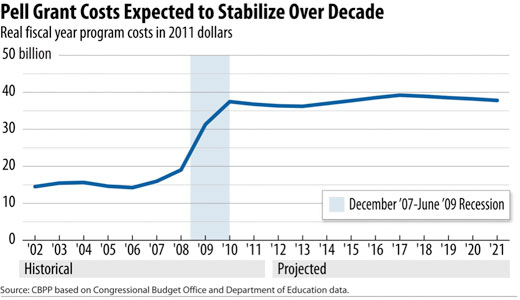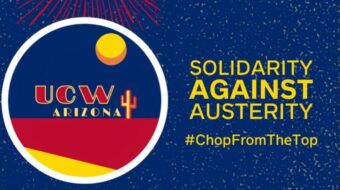
The president’s emphasis on education in his Osawatomie speech frankly means that free or highly subsidized subsidized higher education should be an explicit part, not just phrasemaking, of the domestic policy agenda.
Since the great leaps forward in education in the 1960s and 1970s, many barriers to both access to and completion of higher learning have arisen, and most are consequences of a sustained attack by Republicans on what used to be a bipartisan consensus for a well-established role for government.
Despite these attacks and the consequent rise of education costs above what working-class families can afford, there have been some recent accomplishments that perhaps have not gotten enough recognition, except from conservatives who are actively hacking away at them. Namely, the increase in Pell grants.
Around 10 million undergraduates get help from Pell Grants these days, and the maximum grant was recently raised to $5,550. The figures below show a) the increase in Pell spending and b) the increase in the share of undergrads with Pell grants.
Jared Bernstein offers some comments on these numbers: “Importantly, according to the Department of Education, about 40 percent of the increased expenditures in the top figure is cyclical, i.e., due to the increase in college attendance that you expect to see in recession, as job opportunities become scarce. The rest would then be attributable to increased eligibility and higher grants.”
This shows the administrations efforts in the face of the bleating ignoramuses chorus from the extreme fundamentalist Christian factions. Plus college tuitions have gone up too, almost as fast as health care, while incomes for most families have fallen in real terms.
As Kelsey Merrick has written: “…expansions to the Pell Grant program successfully shielded low- and moderate-income students from tuition increases in 2010. But the maximum award currently covers only 10 percent to 15 percent of the average costs of a four-year college.”
Pell grants will not by themselves overcome all the barriers kids from less advantaged families face in accessing and completing college, though they help. So why is the right wing gunning for the program?
Basically, because it’s increasing and any government spending outside of defense is automatically guilty without a trial, even though the trend is expected to flatten out soon.
Jared Bernstein writes, “The appropriations bill just negotiated cuts the number of Pell-eligible semesters from 18 to 12, thereby generally limiting grants to six years. It also reduces the family income level at which students would be automatically eligible for the grant from $30,000 to $23,000 (though higher income families can get grants depending on their means and the cost of their school).”
It’s not unreasonable to limit semesters of Pell but given that the six-year college completion rate is down to about 50 percent, the trends are very worrisome.
Here are immediate remedies that should be incorporated into the president’s program:
1. Support for programs that smooth the transition from two- and four-year colleges
2. Protect Pell grants for families in the bottom half of the income scale
3. Federal countercyclical policy that automatically holds down tuition increases at public colleges in recession.
But producing a 21st century workforce that can lift the next generation higher requires more than short-term remedies. Markets appear to place no cost on the failure to provide for the young and the unborn. But the cost is vast. I do not agree with Paul Krugman and some others, by the way, who claim there is no “structural” crisis in the workforce. The mismatch of skills and the opportunities and requirements of the future is vast and still growing. An entire industrial paradigm that planned for the future from the New Deal/World War II era has been crushed by the Reaganite financialization binge – and there is currently nothing in its place.
On education and youth, Mr. President, the time for action is now.
Photo: Department of Education/Center for Budget Priorities

MOST POPULAR TODAY


Zionist organizations leading campaign to stop ceasefire resolutions in D.C. area

Communist Karol Cariola elected president of Chile’s legislature

Afghanistan’s socialist years: The promising future killed off by U.S. imperialism

High Court essentially bans demonstrations, freedom of assembly in Deep South






Comments